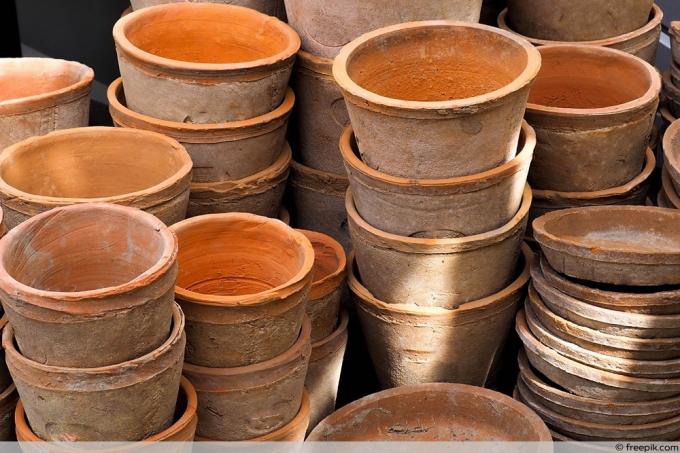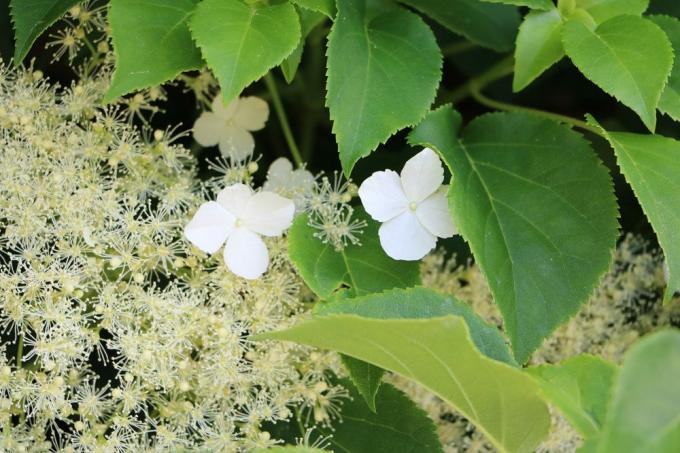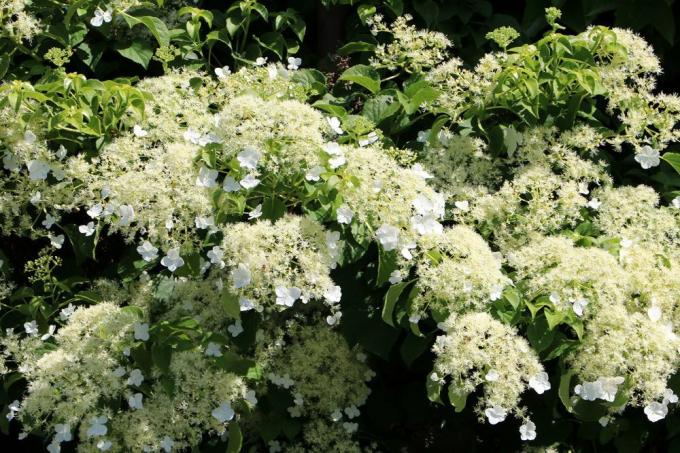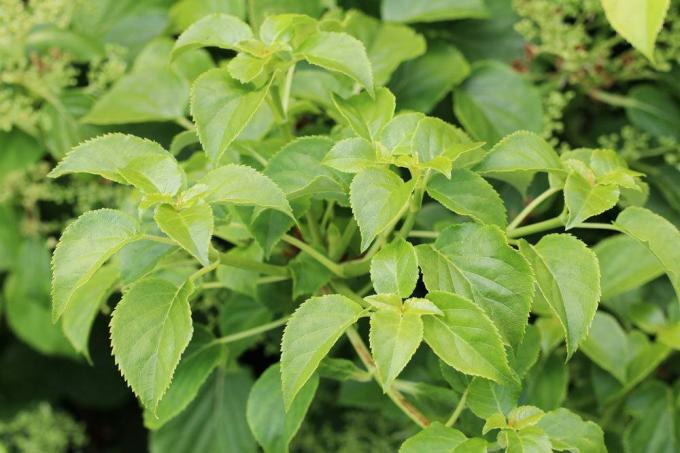
table of contents
- Versatile use possible
- Large planter necessary
- Correct substrate is important
- Pot the hydrangea properly
- Choice of location
- Sufficient watering
- Fertilizer application during the growth phase
- Cut back in moderation
- Climbing and fall protection
- Winter in the bucket
The climbing hydrangeas, which originally come from Asia, also cut a good figure in this country. They are suitable for planting outdoors, but also in pots. However, there are a few things to consider.
Versatile use possible
The climbing hydrangea (Hydrangea petiolaris) is a perennial climbing plant. It is used for the greening of facades, walls, fences and trellises. She is also very popular as Privacy screen used on terraces and for the seating area in the garden. Their dense green foliage and the imposing, large, umbrella-shaped inflorescences from May to July make them so popular. Usually it is planted directly in the field for this purpose. Here she can easily climb a height of up to 15 meters. However, it is also possible to keep the Hydrangea petiolaris in a large bucket or pot. Popular varieties for a container planting are

"Silver Lining"
- Growth height 150 to 200 cm
- Spread 150 to 200 cm
- white flowers from July to August
- white-green variegated leaves
- evergreen
"Cordifolia"
- a dwarf form
- Height of growth 60 to 300 cm
- Spread 40 cm
- Creamy white flowers from June to July
- heart-shaped foliage leaves
- summer green
When planting in a tub or pot, however, there are a few things to consider in order to enjoy the climbing hydrangea in its full beauty. Here are a few tips on how to do this.
Tip: The flower umbels of the climbing hydrangea are often cut for the vase. They last a long time and give off a sweet smell.
Large planter necessary

First, the planter must be selected. Even if the climbing hydrangea does not grow as big in a tub or pot as it does outdoors, the choice of planter is crucial for it to thrive. Annually, the climbing plant can be expected to grow by 15 to 20 centimeters at a young age and even up to 40 centimeters in old age. That certainly says something about the size of the planter. The motto here is: “The bigger and deeper, the better for the plant”. But not only the size, but also the material must be taken into account, if only because of the stability of the climbing hydrangea. The bucket or pot should have
- Minimum volume of 10 to 30 liters
- sufficient water drainage holes on the floor
- a light color to reflect the sun's rays
- this prevents the roots from heating up
In addition, the vessels should
- be stable and thick-walled
- made of ceramic, terracotta or concrete
- have small feet
- alternatively insert blocks
- important so that excess water drains off
- no coasters
Correct substrate is important
There are also a few things to consider when choosing the substrate. In order to keep a climbing hydrangea in a pot, the soil substrate used is important. It can be very peculiar here. In its original home, the climbing plant grows in the forests in a loose, humus-rich and nutrient-rich soil. Besides that is just as important

- a pH between 5.5 and 6.5
- slightly acidic is ideal
- no lime
- permeable and at the same time water-storing substrate
- no waterlogging
- no compaction of the earth
It should be distanced from the normal standard potting soil. It is not particularly suitable. Alternatively, you can mix the potting soil yourself. There are different options:
Mixture consisting of
- Bog bed and rhododendron soil
- 20 percent quartz sand, expanded clay or fine chippings
Mixture consisting of

- two parts of white peat
- two parts of garden soil
- a part of lava granules
- two parts of leaf compost
- a handful of horn shavings and
alternatively a mixture of
- Leaf earth
- Bark humus
- Clay
- Coconut fiber substrate
- Horn shavings and
- Perlite
Unfortunately, it is seldom possible to estimate the pH value of the soil you have mixed yourself in advance. A test should then be carried out afterwards. The necessary test strips are available in every gardening or hardware store. Sometimes the soil mix has to be changed in terms of acidity:
- pH value below 5.5. Addition of garden or algae lime
- pH value above 6.5 Addition of alum (potassium aluminum sulfate) or peat
Pot the hydrangea properly

Usually climbing hydrangeas are offered as container plants. These can be planted all year round. In order to keep the climbing hydrangea in the pot or bucket for as long as possible, it must be properly potted. The procedure is as follows:
- Soak the root ball in a bucket with rainwater or stale tap water
- Application of drainage to the bottom of the pot
- Use of potsherds, expanded clay or grit
- Lay water-permeable and breathable fleece over it
- prevents mixing of soil and inorganic substrate
- then fill up a third of the earth
- Insert the root ball in the middle
- Fill in the remaining soil substrate
- Lightly press the earth down in between
- Prevent the formation of cavities
- Fill up to the bottom pair of leaves at most
- Leave 3 to 5 cm of the pouring edge free
- Pour in vigorously until excess water flows out of the drainage holes
If a climbing aid is already integrated in the plant pot, then the lower tendrils can be tied to the existing struts at the end. But be careful, the twine must not damage the plant tissue.
Note: When using terracotta planters, they should be watered for at least 24 hours. Otherwise it can easily happen that the porous material removes the moisture from the plant.
Choice of location
When choosing the location, the growth and flowering of the climbing hydrangea is decided. He should

- be partially to shady and sheltered from the wind
- rather cool and damp
- but still not too dark
- ideal light shade
- optimal north wall of the house or shady terrace
In addition, the climbing plant can also thrive in a sunny place in a westerly and easterly direction. However, more frequent watering is then necessary during the summer months. In general, the lighter the location, the more splendid the color of the leaves in autumn.
Note: If the location is too dark, there will be no flower formation. On the other hand, direct sunlight can burn the flowers and leaves.
Sufficient watering
Like all other hydrangeas, the climbing hydrangea has a high water requirement. You have to pay particular attention to the quality of the irrigation water, because the plants do not tolerate lime well. Please note when pouring:
- Use of rainwater or decalcified tap water
- Only pour when the surface of the earth is slightly dry
- Pour slowly and carefully onto the root disc
- Do not water the plant
- Sufficient water is provided if excess water runs off through drainage holes
- Watering intervals shorter in sunny locations
- Avoid waterlogging

Especially in summer, when there is dense foliage and flowers, the plant evaporates a lot of moisture and the watering does not last very long. Daily watering is usually necessary.
Note: The finger test can be used to determine the water requirement. To do this, press the index finger one to two centimeters deep into the substrate. If it is still damp there, no watering is necessary. Otherwise waterlogging can quickly develop.
Fertilizer application during the growth phase
Liquid fertilizer should be used for climbing hydrangeas in the bucket. The trade offers special hydrangea fertilizers for this purpose. It contains all the necessary nutrients and trace elements. It is best to proceed as follows:
- Fertilize in the months of April to September
- every two weeks
- Give with the irrigation water
- Mixture as specified by the manufacturer
- Pour clear water before and after fertilization
- alternatively use of comfrey brew
Cut back in moderation

The climbing hydrangea grows relatively slowly. A pruning is therefore not absolutely necessary if there is enough space. It might look different when it comes to keeping a bucket. The following should be said briefly:
- Shorten the tendrils of young plants in late winter by a third
- favors bushy growth
- older plants directly after flowering topiary
- already plant new buds in the previous year
- Shorten tendrils that are too long to the next leaf bud
- Regularly clean withered flowers
- Remove dead and weak shoots
- It is possible to cut back into the old wood
Climbing and fall protection
Climbing hydrangeas are self-climbing. However, they only have adhesive roots on young shoots. Due to the growth in thickness over the years, the adhesive root can tear off quickly. Then it is only possible to hold on to the young shoots. In wind and storm, the plant can be completely torn off the facade. In addition, you should also attach a rope system to secure plants in a pot.

A pot or tub with an integrated climbing aid can be used to achieve the desired direction of growth for the climbing hydrangea. The shoots hold tight here. Climbing aids such as
- Trellises made of wood or metal
- Climbing nets
- Wire frame
- cast iron pyramids and obelisks
can be used.
Winter in the bucket
Usually a climbing hydrangea is hardy. However, kept in the bucket, some precautions must be taken:
- Wrap the pot with insulating material
- Use of bubble wrap, jute bags, garden fleece
- Cover the root ball with brushwood or straw
Alternatively: around the pot with the plant if possible
- pulling a wire mesh
- Fill the gaps with leaves, straw or earth
In addition, young plants should be completely covered with a breathable hood in the first three to five years of very heavy frosts.
Note: All parts of the plant are slightly poisonous. They can easily cause symptoms of poisoning such as dizziness, nausea or a contact allergy. Gloves should be worn when handling.



